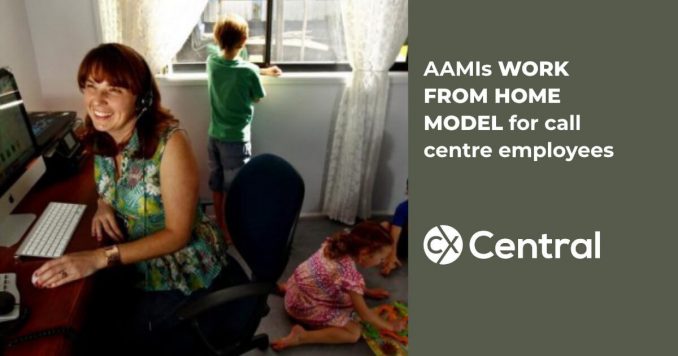
Insight into AAMI’s work from home call centre model
From the editor: This article was first published in 2014, well before COVID made working from home the norm and a large percentage of offshore call centre work came back to Australia.
At that time, many businesses were reluctant to try using a remote workforce with fears of losing productivity and quality by not having the agents onsite.
Of course, most (if not all) of those fears were unfounded and most contact centres actually report an increase in most success metrics.
The biggest challenge nowadays to the work from home model for call centre agents is losing their job altogether to Artificial Intelligence.
Whilst it’s got a long way to go, Digital People – combing a digital avatar and AI to enable customers to have a ‘conversation’ with a virtual customer service agent are starting to emerge with AAMI currently trialling the technology.
We’re not sure that they will ever fully replace real humans, but in time, it will no doubt lead to a reduction in jobs.
Read below for the original article as it still contains some great content.
AAMI’s move to remote working
We hear mixed reviews on the success of home agents however a recent article on SMH certainly paints a pretty positive picture!
And the home call centre agent looks like showing no signs of slowing down with over 30% of Australian call centres already offering work from home options for their employees.
And with Hosted PBX solutions, setting up a call centre home agent model has never been easier.
Fully scalable, low cost and with access to all the same functionality as a desk-based call centre agent – all you need is an internet connection and an IP Telephone.
AAMI’s work from home call centre model is bucking the trend and paying dividends for all parties.
Three mornings a week, Shermaine Fitzgerald sends her three young children to school and childcare, and then commutes the few metres from the kitchen to her home call centre office to take calls for insurance company AAMI.
On the occasional day that one of the children is homesick, they have learnt to sit quietly and draw.
“They’re amazing. They know if they don’t behave I will have to go back to the office, and they love having me at home,” she says.
Mark West, another AAMI employee works from home three days a week to be near his 10-year-old son.
Apart from the occasional yapping of two large Great Dane crossbreed dogs, customers rarely know Mr West works from home.
If anything, they often say how quiet it is compared with noisy call centres.
These homes near Newcastle seem anything but “electronic sweatshops” – the term often used for call centres because of their high turnover and density of staff.
Work from home was touted five to six years ago as the next big thing.
However, Australia has lagged behind the US, where many large call centres had realised that hiring stay-at-home parents resulted in better retention rates and lower costs, Tim Morse, a former senior partner with consultants McKinsey & Co, said.
Apart from Vodafone, which increased local reps saying customers were sick of overseas reps, most companies continue to move service abroad.
AAMI is bucking the trend.
Within a year, about 50 per cent of its service reps, of whom 80 per cent are parents, will be working from home offices.
Many log on at night or early in the morning; others work during school hours.
“Our people love it so we want to continue expanding it,” AAMI head of distribution Renae Bullen said.
The insurer has been testing two different work-from-home models.
In Newcastle, work from home is a privilege offered to the existing customer service reps.
In Narre Warren, Victoria, it is hiring new work-from-home reps who live within 30 minutes of a hub that offers training or a change of scenery.
What are the benefits of home agents?
“Employee engagement is improved, customer experience is better if not the same, and turn-off and absenteeism is improved,” Ms Bullen said. Retention rates were also higher than the industry average.
Ms Fitzgerald, of Gwandalan, said she worked harder because she wanted to continue the arrangement. “Not all workplaces offer that. Because it suits my lifestyle, I really want to make sure it works.”
Graham Howard, a consulting director with LimeBridge, a company that deals in customer experiences, said Australia was still not seeing many companies increase their local customer service operations.
“The wage arbitrage is so great that if companies have got to improve the bottom line, offshoring is the simplest way, quickest way of getting cost savings,” he said.
If customer service cost a dollar in Australia, it would cost 35¢ in India, 45¢ in the Philippines, and 55¢ in Cape Town, South Africa, where some companies were moving.
But Ms Bullen said it was not only about the costs.
AAMI was trying to turn the industry on its head and see if it could make working in a call centre – remotely and on-site – a great experience.
Recommended Links:
